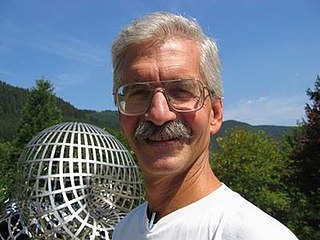
Quantum chaos is a branch of physics focused on how chaotic classical dynamical systems can be described in terms of quantum theory. The primary question that quantum chaos seeks to answer is: "What is the relationship between quantum mechanics and classical chaos?" The correspondence principle states that classical mechanics is the classical limit of quantum mechanics, specifically in the limit as the ratio of the Planck constant to the action of the system tends to zero. If this is true, then there must be quantum mechanisms underlying classical chaos. If quantum mechanics does not demonstrate an exponential sensitivity to initial conditions, how can exponential sensitivity to initial conditions arise in classical chaos, which must be the correspondence principle limit of quantum mechanics?
In mathematics, the Hilbert–Pólya conjecture states that the non-trivial zeros of the Riemann zeta function correspond to eigenvalues of a self-adjoint operator. It is a possible approach to the Riemann hypothesis, by means of spectral theory.

Jean Louis, baron Bourgain was a Belgian mathematician. He was awarded the Fields Medal in 1994 in recognition of his work on several core topics of mathematical analysis such as the geometry of Banach spaces, harmonic analysis, ergodic theory and nonlinear partial differential equations from mathematical physics.

Terence Chi-Shen Tao is an Australian-American mathematician, Fields medalist, and professor of mathematics at the University of California, Los Angeles (UCLA), where he holds the James and Carol Collins Chair in the College of Letters and Sciences. His research includes topics in harmonic analysis, partial differential equations, algebraic combinatorics, arithmetic combinatorics, geometric combinatorics, probability theory, compressed sensing and analytic number theory.
In mathematics, the transfer operator encodes information about an iterated map and is frequently used to study the behavior of dynamical systems, statistical mechanics, quantum chaos and fractals. In all usual cases, the largest eigenvalue is 1, and the corresponding eigenvector is the invariant measure of the system.

Nicholas Michael Katz is an American mathematician, working in arithmetic geometry, particularly on p-adic methods, monodromy and moduli problems, and number theory. He is currently a professor of Mathematics at Princeton University and an editor of the journal Annals of Mathematics.

Peter Clive Sarnak is a South African-born mathematician with dual South-African and American nationalities. Sarnak has been a member of the permanent faculty of the School of Mathematics at the Institute for Advanced Study since 2007. He is also Eugene Higgins Professor of Mathematics at Princeton University since 2002, succeeding Sir Andrew Wiles, and is an editor of the Annals of Mathematics. He is known for his work in analytic number theory. He was member of the Board of Adjudicators and for one period chairman of the selection committee for the Mathematics award, given under the auspices of the Shaw Prize.

Kannan Soundararajan is an Indian-born American mathematician and a professor of mathematics at Stanford University. Before moving to Stanford in 2006, he was a faculty member at University of Michigan, where he had also pursued his undergraduate studies. His main research interest is in analytic number theory, particularly in the subfields of automorphic L-functions, and multiplicative number theory.

Nina Claire Snaith is a British mathematician at the University of Bristol working in random matrix theory and quantum chaos.

John Brian Conrey is an American mathematician and the executive director of the American Institute of Mathematics. His research interests are in number theory, specifically analysis of L-functions and the Riemann zeta function.

In mathematics, the Riemann hypothesis is the conjecture that the Riemann zeta function has its zeros only at the negative even integers and complex numbers with real part 1/2. Many consider it to be the most important unsolved problem in pure mathematics. It is of great interest in number theory because it implies results about the distribution of prime numbers. It was proposed by Bernhard Riemann, after whom it is named.

In mathematics, Montgomery's pair correlation conjecture is a conjecture made by Hugh Montgomery that the pair correlation between pairs of zeros of the Riemann zeta function is
Percy Alec Deift is a mathematician known for his work on spectral theory, integrable systems, random matrix theory and Riemann–Hilbert problems.

Elon Lindenstrauss is an Israeli mathematician, and a winner of the 2010 Fields Medal.
Dennis Arnold Hejhal is an American mathematician. In his mathematical research he frequently uses extensive computer calculation.
Jonathan Peter Keating is a British mathematician. As of September 2019, he is the Sedleian Professor of Natural Philosophy at the University of Oxford, and from 2012 to 2019 was the Henry Overton Wills Professor of Mathematics at the University of Bristol, where he served as Dean of the Faculty of Science (2009–2013). He has made contributions to applied mathematics and mathematical physics, in particular to quantum chaos, random matrix theory and number theory.

William Drexel Duke is an American mathematician specializing in number theory. Duke studied at the University of New Mexico and then at New York University, from which he received his Ph.D. in 1986 under the direction of Peter Sarnak. After a postdoctoral stint at the University of California, San Diego he joined the faculty of Rutgers University, where he stayed until becoming a Professor of Mathematics at the University of California, Los Angeles (UCLA). He was Chair of the mathematics department at UCLA from 2015 to 2018.
Arithmetic Fuchsian groups are a special class of Fuchsian groups constructed using orders in quaternion algebras. They are particular instances of arithmetic groups. The prototypical example of an arithmetic Fuchsian group is the modular group . They, and the hyperbolic surface associated to their action on the hyperbolic plane often exhibit particularly regular behaviour among Fuchsian groups and hyperbolic surfaces.

Steven Morris Zelditch was an American mathematician, specializing in global analysis, complex geometry, and mathematical physics.
Péter Varjú is a Hungarian mathematician that works in harmonic analysis and ergodic theory.













